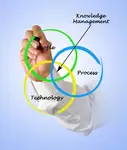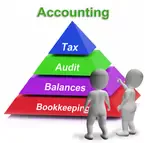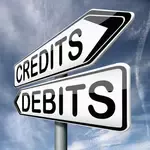- Home
- Basic Bookkeeping Practices
- Booking Aggregate Purchases
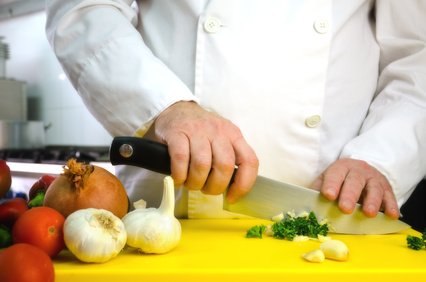
Bookkeeping For Small Restaurants
What Gets Expensed and What Gets Capitalized?

by L. Kenway BComm CPB Retired
This is the year you get all your ducks in a row!
Published January 2011 | Edited June 5, 2024
Determining when to capitalize or expense purchases can sometimes be challenging especially when doing bookkeeping for small restaurants.
Quick Links
✔ CRA's questions to help you decide when to capitalize and when to expense a purchase
✔ Small restaurant purchases and expenses
✔ How to know if something should be expensed or capitalized
✔ Purchasing plates and glasses for a restaurant
✔ CRFA Canadian Restaurant Accounting Standards
In January 2014, the IRS issued final repair regulations as guidance on when to expense and when to capitalize. As a result, I've pulled together common questions asked in the forum surrounding aggregate purchases of low cost capital assets and CRA's take on the subject.
Many restaurants deal in cash. CRA does not allow cash basis accounting unless you are a farmer or fisherman. (See U.S. position here.)
The cash basis of accounting is generally not in conformance with GAAP. It does not present an accurate picture of the financial status of the business. You should know that the Income Tax Act (ITA) is based on GAAP as it's starting point.
A bookkeeping beginner had some questions concerning bookkeeping for a very small family restaurant.
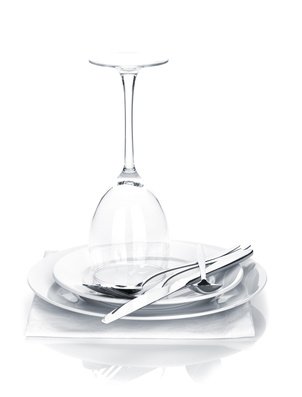
Jade from Richmond, BC
1. For start up, if the business purchased large amounts of utensils/plate/bowls/supplies etc around $600/800/300/1000 at different times in the first 2 months. Should those be capitalized or expensed?
2. For small equipments that have been purchased, such as coffee maker at around $250, should I just expense that? How should I justify when to capitalize or expense equipments/high $ value supplies? by the total amount spent?
3. I have a receipt for the start up renovation of the store, such as painting, some fixtures, installations totaling $3500, how should I record this entry? If the property is rented, should I capitalize that as "leasehold improvements"? or do I need to determine exactly what the services performed were and record it to appropriate accounts?
4. For gasoline, if the owner drives the car 30% for business use. Should I only record 30% of the gasoline amount paid from every receipts? (If I'm doing separate entries on Simply Accounting for every receipts)
5. Other things include the design of the business logo and outside store name sign (light box?) Are these leasehold improvements or what should the appropriate account be?
Sorry if my questions are confusing :S It would be great if anyone have any thoughts about these.
Many thanks!
U.S. Perspective
This same question was also asked in a U.S. forum. For the U.S. perspective, click here. Just keep in mind that the final repairs regulations were issued in January 2014 so the $500 no longer applies in the U.S. It is now $200.
I want to start by saying I have limited experience with bookkeeping
for a small restaurant. But strictly from a bookkeeping perspective,
I'll give you my two cents.
1 and 2. CRA has a set of questions to help you decide when you need to capitalize an expense.
Take the time to read about capital cost allowance used for income tax preparation in Canada. (In the U.S. the IRS equivalent is depreciation for tax purposes.) It helps you determine how CRA classifies capital costs into different classes. For example, class 12 includes china, cutlery, linen, uniforms.
Generally
you capitalize the coffee maker and any other small kitchen appliances
which cost $500 or less if they were purchased at the same time or
within days of each other. The CCA class would be class 12. Once a tool or appliance is over $500, it is classed in Class 8.
The reasoning behind this was explained very well in the U.S. forum (see side bar) and holds true in Canada as well.
"For financial statement purposes (not tax purposes) expensing or deducting an aggregate amount of assets (having a life longer than a year) which is material or significant to your annual revenues will distort your true operating performance and may give you a false picture of your real net income and how well you are or are not doing. For tax purposes, as long as you follow the guidelines, the government could care less."
3. Generally, renovations to rental property are captured under an asset account called Leasehold Improvements. It is classified as CCA class 13 for income tax purposes and is for such things as improvements to a leased space. It does not include substantial alterations to leased premises. These should be captured and accounted for under buildings class 1, 3 or 6.
4. There are special rules for claiming business use of your personal vehicle. Make sure to keep an auto log to prove your business use.
You can record all your vehicle expenses in your books. In your chart of accounts, setup an parent account called "Vehicle Expenses". Then setup sub accounts for the expenses categories CRA requires on Schedule T2125 at 100% of the receipt.
Also setup one more sub account to capture "Personal Use of Auto". At year-end, reduce the auto expenses by crediting "Personal Use of Auto" for 70% of the total (in your example) and debiting "Owner's Draw". Your net vehicle expenses would then be showing 30% if you've done the entry correctly and ... bonus ... you have a complete audit trail in the event of an audit. Also make an input tax credit adjustment for the personal amount by debiting GST/HST Payable and crediting "Owner's Draw".
5. Where you classify these is unique to your situation and a good thing to discuss with your accountant. Dollar value has to be considered here. The design costs for both could be classified under marketing expenses or as an eligible capital expenditure. The store sign / light box would be a fixed asset under CCA class 8.
Whatever decisions you make, make sure you keep a list of your decisions to give your accountant. If s/he doesn't agree with your decision, the entries will be journalled to a more appropriate account at year-end.
Purchasing plates and glasses for a small restaurant
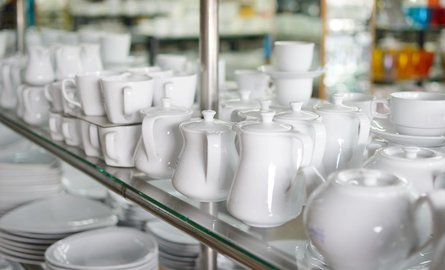
A student of accounting from Vancouver, BC
Should plates & glasses bought for a restaurant be capitalized or expensed? If it's larger quantities (say over $200) would it be capital and a few small replacement items be an operating expense?
I am unsure if there is an enduring benefit or useful economic life over 2 year, due to the frequency that such items can be chipped and/or broken.
Thanks for your help!
Sometimes bookkeeping / accounting work requires the use of judgement based on the unique circumstances of the transaction and / or the business ...
In my opinion, if the purchases were capitalized, they would fall under class 12 which has a CCA rate of 100%. Most Class 12 items are NOT subject to the half year rule. For tax purposes these additions are depreciated at 100% which is the equivalent of being expensed.
It seems the CRA recognize that these types of items have a short life due to wear and tear as you suggest and Class 12 was created to address that.
Before I made my final decision, I would attempt to find out what the industry standard is. Deciding how to classify aggregate purchases each under $500 was discussed earlier in this chat.
How to know if something should be expensed or capitalized in a small office with kitchen?
Sarah from Burnaby, BC
I'm doing my own bookkeeping for my small office outside my home. I'm confused about how to figure out whether or not to capitalize something or not on the T2125 when it has a value UNDER $500 but an expected life over a year.
Three examples (and I have many more low dollar purchases like these):
1) a calculator that costs $10 and has an expected life of 5+ years.
2) a used fridge that costs $120 and has an expected life of ??? being that it's used.
3) an office chair that costs $80 and has an expected life of 2+ years.
* From what I understand, none of these are considered "Small Tools" as I read the description of that capital class on the CRA website and none of these examples would seem to qualify.
* I took a small business tax seminar given by an accountant at Small Business BC and she said to expense everything that costs under $500 unless you make multiple purchases at once of something (like 2 printers at $300 each = $600).
* But the CRA website description of office expenses clearly says calculators and the like can't go there, so where do you put all these small purchases?
* I have been putting them in office expenses (even the fridge) but I'm not sure that is correct. I had originally capitalized them but realized my spreadsheet for tracking capital expenditures was growing extremely long with low dollar purchases while I only had two purchases on it for which I paid over $500...
So what does everybody else do?
Aggregate purchases of capital assets valued at amounts under $500 are discussed at the beginning of this chat.
These are the other responses made in the forum to this question.
Gunner made an excellent point by stating that the items of low value like the ones you listed are expensed for the sake of materiality which is one of the guiding principles in IFRS.
Another person explained usually anything that is over a certain amount of money and serves the purpose of generating revenue is considered an asset. When I see something over $1000 I classify it as an asset. It really depends on the business. Some businesses go by the $500 rule. Ask yourself how long will this asset/expense last the company.
For further assistance with your decision, see the questions CRA wants you to ask.
Let's Chat About ...
Should it be Expensed or Capitalized? Hmmm
The general limit for expensing capital outlays (fixed assets) is $500 or less in Canada and $200 or less in the U.S. Prior to 2006, the threshold was $200 in Canada.
How do you know when you have to capitalize an expense? CRA provides some questions to ask to assist you in making the decision.
Does the expense provide a lasting benefit? If the answer is yes, then it has to be capitalized. Example - Changing the wood siding on your house to vinyl siding. If you just painted the wood siding, it would not need to be capitalized.
Does the expense maintain the property or improve it? If it improves it, then it has to be capitalized. Example - Replacing wooden stairs with concrete stairs. If you just repaired the wooden stairs, then you would not have to capitalize the expense.
Is the expense for a separate asset or for a part of the property? If it is a separate asset, then it has to be capitalized. Example - Replacing a fridge in a rental unit. If you just repaired the fridge by replacing parts, then you would not have to capitalize the expense.
If you still can't decide after reviewing the first three questions, then look at the dollar value of the transaction. If it is a significant amount in relation to the property, then it has to be capitalized. This test on its own is not a determining factor.
There are 2 other special situations which need to have the expense capitalized ... when you buy an older building and repair or renovate it to make it suitable to rent or operate in ... and the cost to fix up your property to sell it.
And finally, legal fees, interest, accounting fees, or property taxes pertaining to an initial purchase, initial construction, or a renovation should be capitalized.

See you on the next page ...
Your tutor
Home › Bookkeeping For Small Restaurant › Aggregate Purchases


